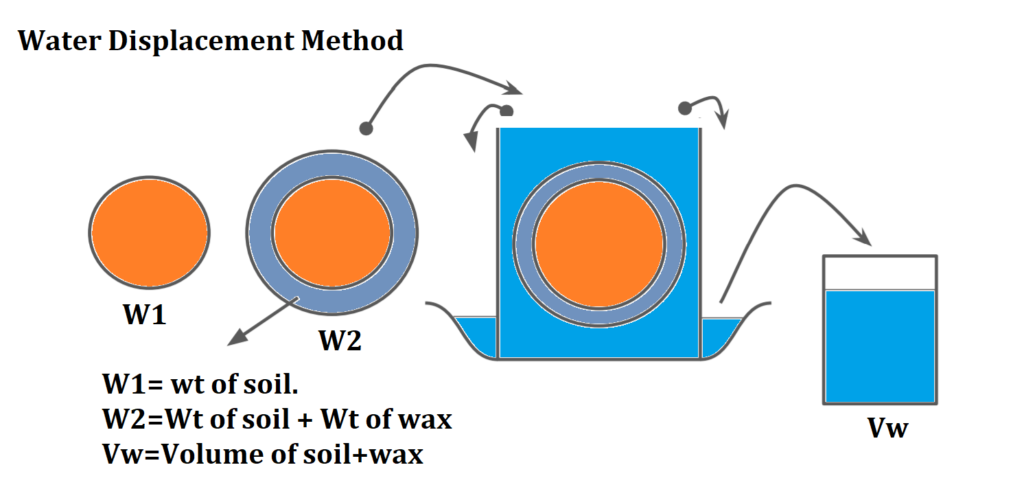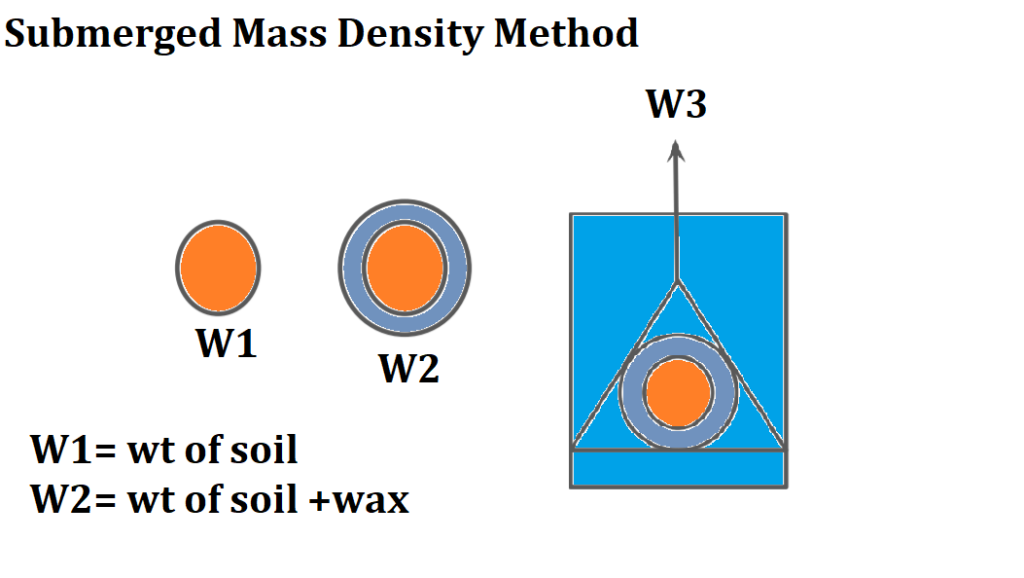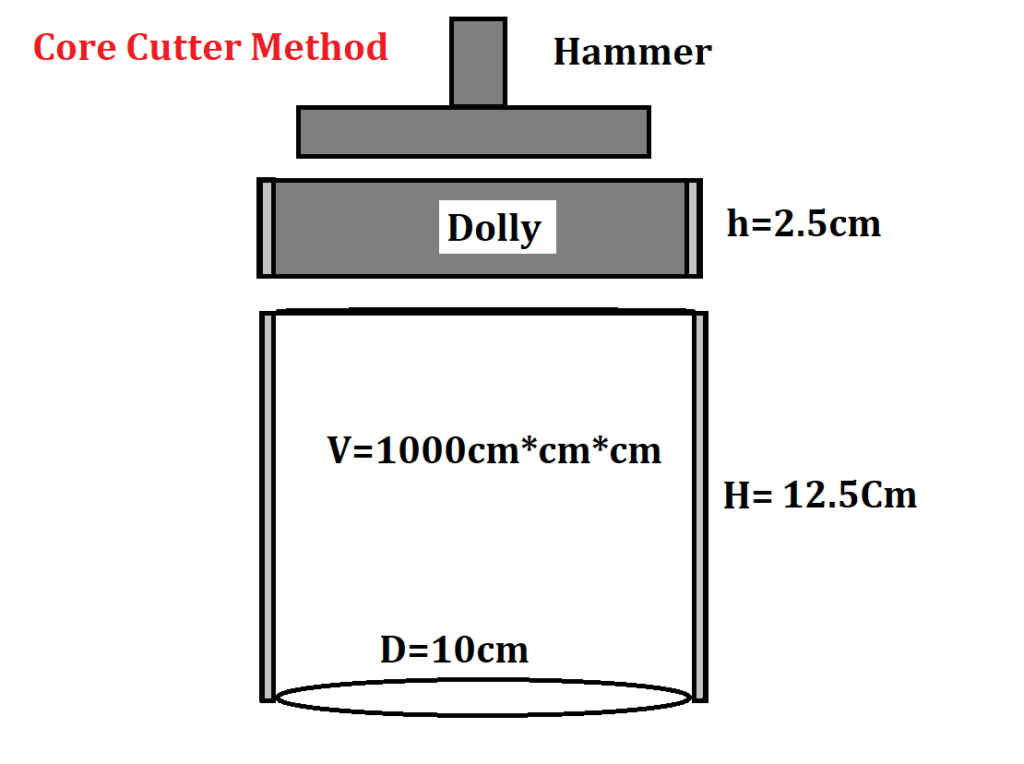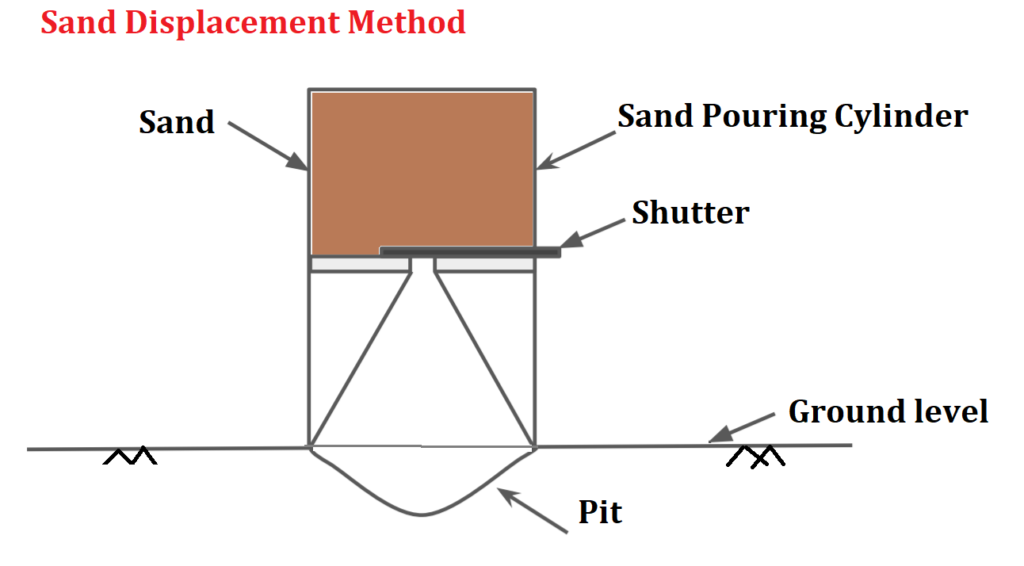Test of Unit Weight of Soil
Test of Unit Weight of Soil can be determined using the following methods. (To calculate density 1. Calculate unit weight, 2. Density=Unit Weight/Gravity)
1. Water Displacement Method
- This method is suitable for cohesive soil which is highly sticky in nature.
- In this method sample of soil is trimmed into more or less uniform shape and weight(W1).
- Sample is the coated with paraffin wax (to prevent the entry of water into the soil) and is again weight (W2).
- The coated specimen of soil is immersed slowly in a container, that is completely filled with water and volume of water displaced by coated specimen is Vw.

Weight of paraffin wax= W2-W1.
Volume of paraffin wax(Vp)=\(\frac{W2-W1}{γ_p}\)
(\(ρ_p=.908 g/ml\) )
Volume of water displacement Vw= Volume of coated soil.
Vw=Volume of soil(V)+ volume of paraffin wax(Vp).
Vw=V+Vp.
V=Vw-Vp
Unit Weight =\(\frac{Weight of soil}{Volume of Soil}\)
Unit Weight =\(\frac{W1}{V}\)
V= Vw-\(\frac{W2-W1}{γ_p}\)
Unit Weight =\(\frac{W1}{Vw-\frac{W2-W1}{γ_p}}\)
2. Submerged Mass Density Method
- This method is suitable for cohesive soil which is highly sticky in nature.
- In this method submerged mass of coated specimen W3 is noted to find volume of water displaced by soil+ paraffin wax.

Weight of paraffin wax= W2-W1.
Volume of paraffin wax(Vp)=\(\frac{W2-W1}{γ_p}\)
(\(ρ_p=.908 g/ml\) )
Submerged weight of coated specimen(W3)= W2-Fb.
Fb= Force of Buoyancy= Vw\(γ_w\)
W3=W2-Fb
W3=W2-Vw\(γ_w\)
Vw=\(\frac{W2-W3}{γ_w}\)
Vw=Volume of soil(V)+ volume of paraffin wax(Vp).
Vw=V+Vp.
V=Vw-Vp.
V=\(\frac{W2-W3}{γ_w}\)–\(\frac{W2-W1}{γ_p}\)
Unit Weight =\(\frac{Weight of soil}{Volume of Soil}\)
Unit Weight =\(\frac{W1}{(\frac{W2-W3}{γ_w})-(\frac{W2-W1}{γ_p})}\)
3. Core Cutter Method
- It is field method which is suitable to be used for cohesive soils.
- This method is generally not suitable for gravel, sand and dry soil.
- It is generally used for soft silt and clay.
- This method consist of a core cutter of volume 1000cc (Diameter=10cm, Height=13cm) is pushed into the ground and then core containing soil is taken out from the ground.
- Weight of core with soil sample (W2) and empty core(W1) is measured & V=1000cc. Hence Unit Weight is given as:

Unit Weight=\(\frac{Weight of Soil}{Volume}\)=\(\frac{W2-W1}{V}\).
4. Sand Replacement Method
- Since core cutter method in not suitable for hard & gravel soil, sand replacement method is used in this case.
- It is field method.
- A small pit is excavated and the excavated soil sample is weighted.
- A calibrated cylinder containing sand is placed over the excavated pit and is filled with sand.
- volume of the pit is obtained from the calibrated cylinder.
- It is suitable for gravel, sand and dry soil.
- the bulk unit weight is calculated as:


Unit Weight=\(\frac{Weight of Soil}{Volume}\)
| Subject | Soil Mechanics |
| Unit | Soil Formation & Properties of Soil |
| Topic | Test of Unit Weight of Soil |
| Next Topic | Particle Size Distribution |
| Previous Topic | Test of Specific Gravity |